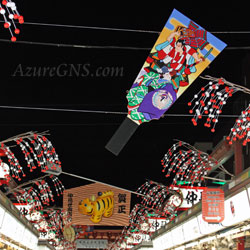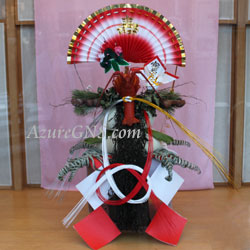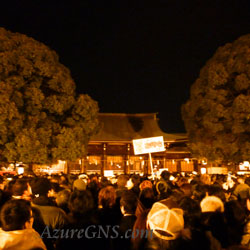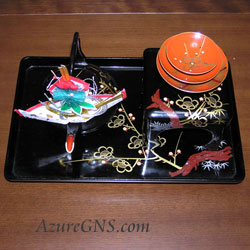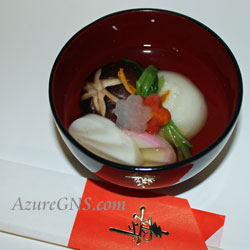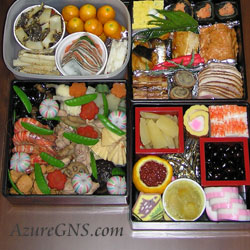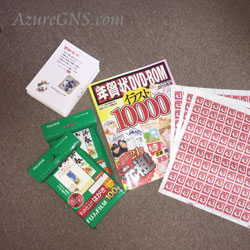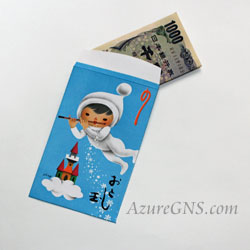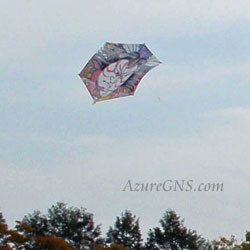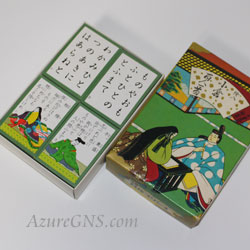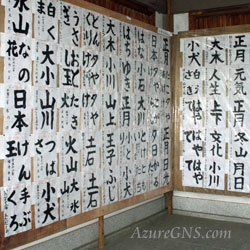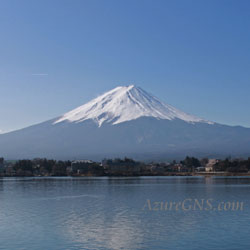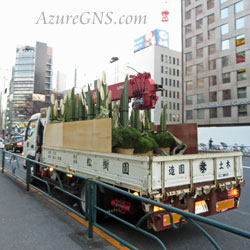国民の祝日
元旦 (1月1日)と
お正月(1月1日から15日まで)
National Holiday
Gantan
New Year’s Day (January 1st)
and O-shogatsu, New Year (from January 1st to the 15th)
●元旦 gantan; New Year’s Day
●お正月 O-shogatsu; New Year
●正月休み New Year holiday
●祝い celebration
●新年の抱負 New Year’s resolution
●神社 (Shinto) shrine
●年賀状 New Year’s greeting card
●書き初め Kakizome; first calligraphy practice;
special New Year calligraphy
●お年玉 O-toshidama; New Year’s gift; (お年玉や祝い)handsel
●餅 mochiI; rice cake
●交通渋滞 traffic jam; holdup; 【米Am.】(交通事故などによる)tie-up
●伝統 tradition
◆日本で1年の中で最も大切な休日はお正月、新年のお祝いです。
In Japan, the most important holiday season of the year is O-shogatsu, New Year’s Celebration.
◆多くの日本人は1年をひとつの区切りと考えるので、お正月は新しい始まりとされており、きちんと迎えることはとても大切です。
Since many Japanese think of each year as an independent unit, it represents a new beginning, and starting it correctly is very significant.
◆お正月は1月1日から7日まで、または15日までですが、三が日と呼ばれる最初の3日は最も大切です。
O-shogatsu is from January 1st to the 7th or the15th, but the first three days, Sanganichi are the most important.
◆お正月休みは4月末から始まるゴールデン・ウイーク、8月のお盆休みと並んで、日本で最も長い約1週間の休暇です。
The New Year’s holiday is the longest holiday in Japan, about 1 week long, in addition to the Golden Week from the end of April and the O-bon holiday in August.
◆学校は12月24日くらいから1月7日くらいまで冬休みです。
Schools have a winter vacation around December 24th through to about January 7th.
◆会社員も12月30日くらいから1月3日か4日くらいまで正月休みです。
Company employees also have a New Year holiday, usually between December 30th and January 3rd or 4th.
◆お正月の準備はたいてい12月の中旬に始まります。
Preparations for O-shogatsu usually begin in the middle of December.
◆お正月の神様をお迎えするため、大掃除が行われます。
Families clean their house thoroughly to welcome the New Year’s gods.
◆家の門か玄関は1組の門松で飾られます。
The gates or the doors of houses are decorated with a pair of kado-matsu.
◆これらは藁、竹、松の枝、梅の枝などの飾りものです。
These are arrangements of straw, bamboo, branches of pine and plum, and so on.
◆家を清め、悪霊が入って来るのを防ぐために、表玄関の上にしめ飾りをかけます。
Above the front door, people hang shime-kazari to purify the home and to prevent evil spirits from entering.
◆この飾りものは橙、羊歯の葉、藁、飾りの紙などでできています。
This decoration consists of a bitter orange, fern leaves, straw, decorative paper, and other ornaments.
◆日本中にさまざまなしめ飾りの材料や形があります。
We can see many shapes of shime-kazari, and various materials are used.
◆家の中では床の間などの大切な場所に年神様のために鏡餅を飾ります。
Indoors, kagami-mochi adorns an important place such as tokonoma (alcove) for a New Year’s Shinto god.
◆三方という特別な台の上に大きな丸い餅をのせ、その上に小さな丸い餅をのせます。
A small round rice cake rests on a larger round rice cake, and is placed on sampo, a special stand.
◆鏡餅は橙、伊勢海老、干し柿、昆布、羊歯、飾りの紙などで飾られます。
Additional materials, such as a bitter orange, a lobster, dried persimmons, kelp, fern leaves, decorative paper, and so on, decorate the kagami-mochi.
◆鏡餅を最初に割り、食べる日を鏡開きと呼び、1月11日です。
Kagami-mochi is first split and is eaten in a traditional ritual called Kagami-biraki on January 11th.
◆正式には鏡餅を刃物で切らずに木槌で割って、焼いたり、善哉に入れたりして食べます。
Formally, kagami-mochi is not cut with a knife, but is split with a mallet before being eaten as baked mochi or zenzai (sweetened adzuki-bean soup with mochi in it).
◆初詣はその年の最初の神社仏閣へのお参りという意味で、0時を過ぎてすぐに始まり、3日の夜まで続きます。
Hatsu-mode, meaning the first shrine or temple visit of the year, begins shortly after midnight on New Year’s Day and continues until midnight of January 3rd.
◆人々はその年の健康や幸せや商売繁昌などを祈ります。
People pray for such things as health, happiness, prosperity in business, and so on, for the year.
◆山を登って、その年の初めての日の出の初日の出を待ち拝むことは、日本の伝統的なお正月の行事のひとつです。
Some people climb mountains and wait and pray for the first sunrise of the New Year, which is called Hatsu-hinode, one of the Japanese traditional rituals of O-shogatsu.
◆初日の出を拝む場所として最も人気があるのは、日本一高く、美しい富士山です。
The most popular spot for Hatsu-hinode is Mt.Fuji because it is the highest and most beautiful mountain in Japan.
◆元旦の朝、家族は集まり正式にはスパイスのきいたお酒であるお屠蘇を飲みます。
On the morning of the 1st, families gather together to formally drink o-toso, spiced sake (Japanese rice wine).
◆お正月の間、お雑煮と呼ばれるお餅や野菜が入ったすまし汁、または味噌汁を食べます。
During O-shogatsu people eat o-zoni: a soup of either plain broth or miso broth containing mochi (rice cakes), and vegetables.
◆魚や鶏肉を加えることもあり、出汁や材料は地方によってさまざまです。
Sometimes fish or chicken is added, and the soup and the ingredients vary from region to region.
◆他のお正月料理と言えばお節料理で、12月末に用意されます。
Another special food for O-shogatu is osechi-ryori, which is prepared at the end of December.
◆お節料理は漆塗りのお重に入った伝統的なお正月の料理です。
Osechi-ryori is traditional New Year’s dishes served in a set of lacquer-ware boxes.
◆縁起が良く、意味のあるさまざまな料理が芸術的に並べられています。
They are various lucky and meaningful dishes, arranged artistically.
◆前もって料理を作るので、主婦は少しの間普段の料理をしなくてもすみます。
Preparing these dishes in advance allows housewives to take a short break from their usual daily cooking.
◆お節料理を作る手間を省きたい人はお節料理をデパートや飲食店に頼むことができます。
People can order Osechi-ryori from department stores or restaurants, saving the trouble of preparing these elaborate dishes.
◆束ねて配達される新年の挨拶状の年賀状は大きな楽しみです。
Nengajo, or New Year’s greeting cards, which are delivered together in a bundle, bring great pleasure.
◆年賀状は特に前年、ほとんど会う機会がなかった親戚や友人の近況が分ります。
Nengajo allow people to come to know how relatives and friends have been getting along, especially those whom they’ve had few chances to see during the year.
◆早い人は11月の始めから書き始め、丁寧に毛筆で書いたり、干支を絵や版画で描いたりする人がいます。
The most organized people start writing Nengajo is at the beginning of November; some write wholeheartedly in Japanese black ink with a writing brush, and some draw a picture of “Eto” (the animal sign of the year among the Twelve Animal Signs of the Oriental Zodiac) or print it by a woodcut.
◆年賀状は印刷屋に発注することができますが、最近は家庭用のコンピューターとプリンターの普及により、自宅で年賀状を印刷する人が年々増えています。
Though Nengajo can be ordered from printers, computers and printers for family use make more and more people print Nengajo at home.
◆家族やペットの写真を載せる人も多く、結婚したり、赤ちゃんが生まれたりすると年賀状に写真を載せて報告することがあります。
Photos of families and pets often appear on Nengajo, and it sometimes plays the role of an announcement of a wedding or a newborn baby with a photo.
◆年賀状は12月中旬から25日ぐらいまでに投函すると元旦に配達されます。
Nengajo posted from the middle of December around to the 25th are supposed to be delivered on New Year’s Day.
◆最近、特に若い人は年賀状を出さずに、メールやSNSで新年の挨拶を送る人が増えています。
Recently, more and more people, especially the young, send their New Year’s message by e-mails or SNS.
◆多くの人がお正月をふるさとで過ごします。
A lot of people spend the New Year vacation in their hometown.
◆長い正月休みの間に国内や海外を旅行する人もいます。
During the long New Year holiday, people also travel around Japan or overseas.
◆交通機関が大変混雑し、道路がひどく渋滞して、宿泊施設やツアー旅行が非常に値上がりします。
Travel facilities are very crowded, and there are terrible traffic jams, and accommodation and package tours are much more expensive.
◆お正月は特に子供にとってわくわくする時です。
O-shogatsu is especially exciting for children.
◆この時期、子供達はお年玉を楽しみにしています。
During this time, children look forward to O-toshidama, a New Year’s gift.
◆これは両親や親戚から子供へのお金の贈り物です。
This is a gift of money from parents and relatives to children.
◆どれくらいそれぞれの子供がもらえるからは年齢や環境によりいろいろです。
How much each child receives varies according to age and circumstances.
◆この習慣は武士や貴族が贈り物を交換した室町時代(1392-1573)にさかのぼります。
This custom dates back to the Muromachi era (1392-1573), when warriors and nobles exchanged gifts.
◆明治時代(1868-1912)、子供へのお金の贈り物が一般に広まりました。
During the Meiji era (1868-1912), gifts of money to children became more popular.
◆お正月の特別な遊びは凧揚げ、駒回し、羽根突きです。
Special New Year’s games are Tako-age (kite flying), Koma-mawashi (top spinning), and Hane-tsuki (Japanese badminton).
◆一種のカードゲームの百人一首をして楽しむ人もいます。
Some enjoy playing Hyakunin-isshu, a type of card game.
◆カードは合計200枚で、100枚の読み札には100人が1種ずつ詠んだ有名な和歌の上の句が書いてあります。
There are 200 cards in total and 100 are reading cards, which hold the first half of famous 100 waka (a 5-7-5-7-7 syllable Japanese traditional poem) each by a different person.
◆残り100枚は取り札で下の句が書いてあります。
The other 100 cards are playing cards, which hold the latter half of waka.
◆読み札の上の句が読み上げられると、取る人はその下の句が書かれたものを畳の上に置かれた取り札の中から探します。
When the first half of waka on the reading card is read, the players look for the card which holds the latter half of waka matching to the reading card among the playing cards placed on the tatami (straw mats).
◆最近、子供達はコンピューターゲームに夢中で、これらの日本の伝統的な遊びはあまりしなくなってきました。
Children are absorbed in computer games; therefore, Japanese traditional games aren’t as common these days.
◆特に都市部で消えつつある伝統的な習慣のひとつは獅子舞です。
One traditional custom which is disappearing, especially in the cities, is Shishi-mai.
◆笛や太鼓にあわせて踊るこの中国の獅子は悪霊を追い払うと考えられています。
This Chinese lion dance, accompanied by a flute and a drum, is thought to drive away evil spirits.
◆2日にその年初めてのお習字の練習をする日本人もいます。
On the 2nd, some Japanese do their first calligraphy practice of the year.
◆この伝統的な習慣は書初めと呼ばれ、自分の信念の抱負を書く人もいます。
This traditional custom is called Kakizome, and some write their New Year’s resolutions.
◆書き初めの起源は宮中での年中行事の「吉書始め」と云われて、江戸時代(1603-1868)に庶民に広まりました。
Kakizome is said to have originated from “Kissho-hajime”, one of the annual events at court, and Kakizome became popular among common people in the Edo period (1603-1868).
◆書き初めで書いたものを小正月に左義長で燃やし、炎が高く上がると字が上達すると云われています。
It is said that if a piece of Kakizome paper is put into the fire of Sagicho (the fire of Ko-shogatsu Festival) and the flames of the fire rise higher, its writer can make more progress in calligraphy.
◆元旦か2日の夜に見る夢は初夢と呼ばれています。
The dream people have on the night of the 1st or 2nd is called Hatsu-yume.
◆富士、鷹、茄子の順で縁起が良いと言われています。
It is said that a dream of Mt. Fuji is the luckiest, that of a hawk is the second luckiest, and that of an eggplant is the third.
◆七福神の乗っている宝船の絵を枕の下に入れて眠ると、良い初夢を見ることができるとされています。
It is said that people will have a good Hatsu-yume, if they put a picture of Takara-bune (the treasure ship) with Shichi-fukujin (the Seven Lucky Deities) under their pillow.
◆1月7日には七草粥を食べる人もいます。 それは7つの春の食べることができる薬草が入った特別なお粥です。
On January 7th, some people eat Nanakusa-gayu, which is special rice gruel with seven edible spring herbs.
◆七草粥は一年中健康に保ってくれると言われています。
It is said that Nanakusa-gayu keeps people healthy throughout the year.
◆七草粥はまた、お正月の間ご馳走を食べて疲れた胃腸を休めるのを助けます。
Nanakusa-gayu also helps to rejuvenate the stomach and intestines, which have worked hard, during the O-shogatsu feasting.
◆お正月の主な3日が終わると、4日にほとんどの人は仕事に戻ります。
On the 4th, most people return to work, as the main three days of O-shogatsu come to an end.
◆年々、新年を祝う準備は簡素化していますが、それでも尚、日本人はお正月をとても重要視しています。
Year after year, people have been increasingly simplifying their preparations for the New Year’s Celebration, yet Japanese still think much of O-shogatsu.
Copyright (C) Azure Global Network Services. All Rights Reserved.

